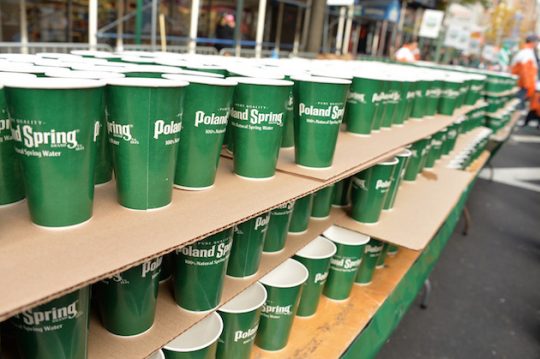A class-action lawsuit is alleging Poland Spring Water and parent company Nestle have been deceiving customers for decades. But do the claims, ahem, hold any water?
"For more than twenty years, Nestle Waters’ marketing and sales of Poland Spring Water has been a colossal fraud perpetrated against American consumers," states the lawsuit, filed last month in Connecticut District Court. Poland Spring does not meet the FDA definition of spring water, the plaintiffs allege. "Rather than being collected from pristine mountain or forest springs as the images on those labels depict, Poland Spring Water products all contain ordinary groundwater that [Nestle] collects from wells it drilled in saturated plains or valleys where the water table is within a few feet of the earth’s surface." What’s more, according to plaintiffs’ attorneys, Poland Spring itself "ran dry nearly 50 years ago."
Naturally, Nestle denies any wrongdoing, insisting in a statement that the allegations "are without merit and an obvious attempt to manipulate the legal system for personal gain." (On its FAQ page, Poland Spring maintains that it faithfully complies with the FDA’s definition of spring water and offers links to its eight springs.)
News of the suit reminded me of the class action filings made against Tito’s Handmade Vodka—plaintiffs were angered to learn the clear spirit wasn’t made entirely by hand and that machines were involved. Therefore it shouldn't be called "handmade." The line by the Poland Spring plaintiffs about the water not being sourced "from pristine mountain or forest springs as the images on those labels depict" had me again wondering if Pepperidge Farms products are really made in that farmhouse powered by a watermill. Do Keebler elves actually bake cookies "in magic ovens in the Hollow Tree" as stated on Keebler’s website? I’m beginning to have my doubts. (An attorney friend in D.C. offered no comment but directed me to this link.)
In 2015 a district judge dismissed five lawsuits against Tito’s Handmade Vodka, and two other cases were dropped the following year. But the complaint against Nestle is considerable: It clocks in at 322 pages (with stats, charts, and aerial photographs) and involves 8 lawyers representing 11 plaintiffs "and on Behalf of All Others Similarly Situated." In total there are 11 claims for relief, including for "compensatory and punitive damages and permanent relief for fraud to members of the Nationwide Class." How big is that class? How many of us drink bottled water? While it remains unclear precisely how much money is at stake, keep in mind we’re talking about a $16 billion industry.
The FDA provides a lengthy definition for spring water—maybe allowing Nestle just enough wiggle room. On the other hand, Nestle has had to settle similar class-action complaints in the past. As reported by the Chicago Tribune in 2003, "[Plaintiff Ken] Ramsey's attorneys were awarded more than $1.3 million in fees. Nestle also agreed to pay out about $8 million in consumer discounts and coupons and make more than $2 million in charitable donations over the next five years. Ramsey is in line to receive $12,000, most of which he said he plans to donate to charity."
If you have your own concerns about Poland Spring, there are, of course, alternatives. You could drink San Pellegrino, Perrier, Acqua Panna, Arrowhead, or Vittel—all of which are owned by Nestle.
But seriously, water doesn’t have to come from aquifers deep beneath the Snake River Plain, Arctic glaciers, or even Fiji for it to taste good. I remember the master distiller of Ketel One Vodka jokingly pointing out the source of the brand’s water. He called it their "glacier" and pointed to a nondescript water purifier. It tasted just as good, he maintained. And he was right, though the vodka tasted better.
